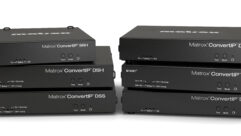Color Management Often a Gap in Video Installations
May 10, 2007 3:45 PM,
By John McKeon
Corporate AV clients are often disappointed in the performance of their video displays without knowing why, or frustrated by their inability to obtain dependable high-quality and consistent color from different displays in a wide variety of viewing environments.
The root of this frustration, some industry experts say, is a failure of color management, and this is an area in which AV integrators could be doing more to support and educate their clients.
The goal of color management is simple: A given image should always look the same, and should look just the way its creators intended it to look. But when an image may be reproduced by computer monitor, an LCD TV, a large plasma screen, a lightweight business projector, a high-end three-chip DLP projector, or a number of other devices, getting that consistency is no easy feat.
Manufacturers have provided more capable and dependable equipment and software than ever before, says Joel Silver, president of the Imaging Science Foundation (ISF). That leaves the color management and calibration ball in the integrator’s court, where Silver fears it is often dropped.
“When I see an adjustment capability that was in a $150,000 product now available in a $3,500 product, I get fired up,” Silver says. “That’s superb progress. What’s criminal is when a manufacturer deploys that adjustment at no small expense and these products get installed without using any of that capability. The very features that define the products as premium products aren’t being deployed.”
Industry veteran Alan Brawn of Brawn Consulting cites several widely held misconceptions about color management. “The biggest areas of misunderstanding relate to the plug-and-play myth that seems to pervade the market,” Brawn says. “Customers assume proper calibration is delivered in the displays they receive, but this is far from the truth. Displays live in different environments and call for different calibrations to take advantage of the space or to counteract elements of the environment that take away from the perfect picture.
“The second area of misunderstanding,” Brawn adds, “is that you can simply turn some controls or knobs to adjust a display.”
In fact, every display technology reproduces color differently and requires a different approach. “LCD is different from LCoS and plasma is different from LCD, and single-chip DLP is different from three-chip DLP,” Brawn says. “Even is a given group of technologies such as plasma, there is a significant difference between a 42in. PDP from NEC than one from Samsung or Panasonic.”
Industry-wide standards are one part of the answer. Silver stresses, however, that more commitment on the part of integrators is also crucial. ISF offers training seminars in the United States and Europe, and although they are aimed at integrators, “we routinely see frustrated end users coming in, spending their time and money trying to get what they paid for out of a TV set. The client has been driving the dealer to get better, which I think is backward.”
Silver says it is up to end users to “be a difficult client. If I put out a bid on a project, I want a bid on products and services. I want products fulfilling my spec within my environment.”
The onus of meeting that standard, he adds, is mostly on the integrator. “The manufacturer can only do half the work,” he says. “They can give you all the tools, but you have to do the installation properly.”










